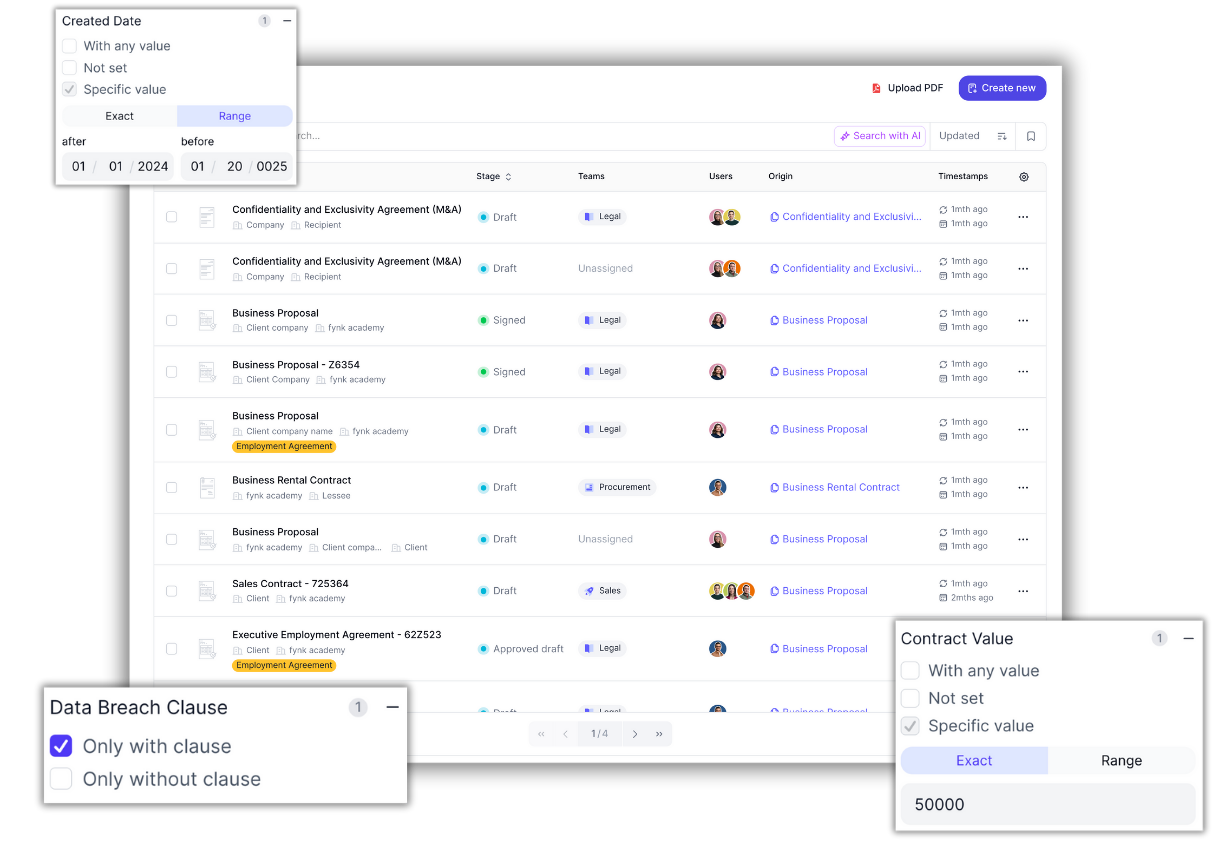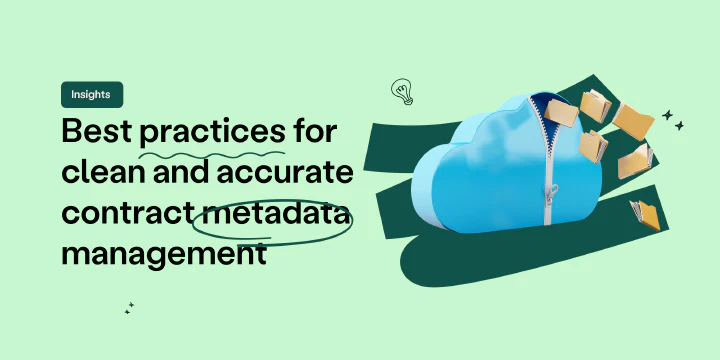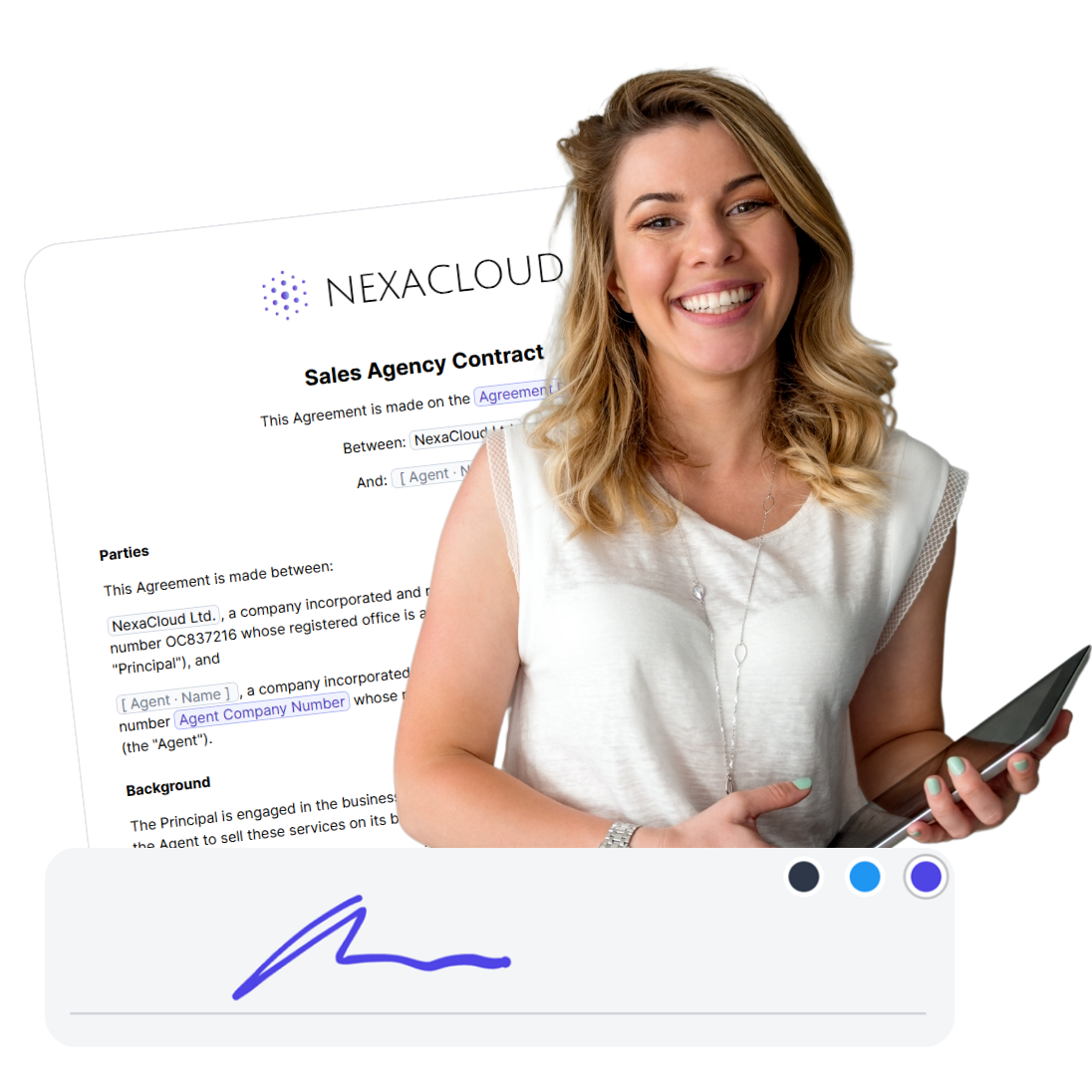Best practices for contract metadata management
Contract metadata is the engine that keeps your entire contract workflow running smoothly. It is the difference between a company that knows exactly what is in its contracts and a company that is constantly reacting to surprises. Clean metadata makes renewals predictable, reporting accurate, automation possible, and contract insights accessible to everyone who needs them. The following best practices will help you create a cleaner, more accurate, and more actionable metadata framework. And with the right CLM system such as fynk, these practices become simple to implement across your entire contract portfolio.
- 1. Use a reliable contract lifecycle management system
- 2. Use a standard list of contract data fields
- 3. Build metadata-driven dashboards
- 4. Use metadata to manage renewals and obligations
- 5. Create contract summaries using key metadata
- 6. Use metadata to improve contract search and retrieval
- 7. Enable bulk metadata editing for large updates
- 8. Use metadata to auto-populate contract templates
- 9. Check metadata for errors automatically
- 10. Assign clear owners for metadata quality and upkeep
- How metadata works in fynk
- Now over to you

1. Use a reliable contract lifecycle management system
A reliable CLM does more than store contracts. It protects contract metadata quality at every step of the lifecycle. If you want clean metadata, you must remove the human error that comes from scattered storage systems.
Here are the practical benefits
- You reduce version confusion. When contracts live in mailboxes or file shares, people update the wrong copy. A CLM keeps one source of truth that metadata always attaches to.
- You capture metadata at the moment of creation. When teams upload contracts manually at the end of the process, metadata gets lost. A good CLM collects fields during drafting, negotiation, or approval which guarantees stronger accuracy.
- You enforce validation rules. For example, start date cannot be later than end date, contract value must contain a number, and currency must follow a controlled list. Humans forget these details. A system does not.
fynk already uses structured templates, required fields, and real time validation which prevents bad data before it enters the system.
2. Use a standard list of contract data fields
Standardization is not about having many fields. It is about having the right fields and naming them in ways that everyone understands.
Practical tips that make a big difference
- Use field names that are plain and unambiguous. For example, Renewal Reminder Date is easier to understand than Notice Period for Termination.
- Use field descriptions so people know exactly what belongs in each field. Teams often mix up Contract Value with Annual Value or Total Contract Value.
- Create different field sets for different contract types. Trying to fit all fields into every contract guarantees garbage data. For example, vendor contracts need service level fields while employment contracts need probation fields.
3. Build metadata-driven dashboards
Dashboards only become powerful when you design them around business decisions, not around pretty charts.
Build dashboards that answer operational questions such as
- Which contracts require action this week.
- Which customers represent the largest renewal risk.
- Which suppliers have missing compliance documentation.
- Which departments are slowing down contract cycle time.
A common mistake is to track only counts. For example, number of active contracts sounds helpful but rarely moves the business forward. Instead, track indicators that trigger decisions such as contracts approaching renewal within ninety days or contracts over a certain threshold lacking approval.
fynk lets you turn any metadata field into a dashboard filter which means your dashboards are always connected to real time contract activity.



fynk user dashboard
4. Use metadata to manage renewals and obligations
Most renewal failures are metadata failures. Teams miss renewal dates because the information lives in a PDF instead of a structured field. Or the field exists but has not been updated after an amendment.
Here is how to avoid it
- Always track two dates. Renewal Date and Last Possible Termination Date. Many teams track only one which introduces risk because most contracts require termination in advance.
- Track renewal type. Auto renewal, manual renewal, fixed term, and evergreen all behave differently. Use drop down lists to enforce consistency.
- Track obligation owners. A contract may contain three obligations assigned to three different people. Without ownership metadata the reminder goes to the wrong team.
When you use fynk, renewal logic and reminders are automated. You link each renewal or obligation to its owner and the platform keeps them informed without manual chasing.



Notification and reminders settings in fynk
5. Create contract summaries using key metadata
Summaries make contracts digestible for business users. To be useful, summaries should combine metadata that describes the contract in a way that a non lawyer can quickly understand.
Useful metadata for summaries
- Commercial essentials such as price, payment cycle, contract term, and renewal type.
- Risk related fields such as liability cap, indemnities, and insurance requirements.
- Operational obligations such as reporting, delivery, or documentation duties.
"The AI is really helpful as well to just sum up the most important things… When I get sent a contract, how the AI puts it together and makes it easy to have a quick overview about the most important points is really helpful."

Founder and Director at maven
fynk uses metadata to produce summaries automatically. This keeps summaries consistent and ensures they always reflect the latest contract version.



AI summary in fynk
6. Use metadata to improve contract search and retrieval
Search becomes reliable when you think about how people search, not how contracts are stored.
Practical strategies for better search
- Tag contracts based on outcome or use case. For example, lead generation contracts, subcontractor agreements for project X, or high risk pricing terms.
- Use controlled vocabularies. If one contract is tagged Supplier and another Vendor, they will not show up together. Controlled lists guarantee consistent categorization.
- Index obligations, risks, and permissions. Teams may need to search for all contracts that contain audit rights or all contracts where the company provides indemnity.
fynk turns every field into a filter and also makes obligations and key clauses searchable which dramatically reduces time wasted digging into PDFs.



AI search in fynk
7. Enable bulk metadata editing for large updates
Bulk editing matters more than most teams realize. Large updates happen frequently in real life such as
- Updating governing law after a company wide policy change.
- Updating responsible owners after a team reorganization.
- Adjusting pricing model metadata after a commercial transformation.
- Applying new categories to legacy contracts after an acquisition.
Without bulk editing you end up with spreadsheets and endless manual work which increases error rate.
magine your company has completed a shift in pricing strategy. Until now, all customer contracts contained two pricing related fields
- Total Contract Value
- Billing Frequency
Your finance team decides to introduce a new metric called Annual Contract Value because it is more reliable for forecasting. This means every active customer contract must now include the correct Annual Contract Value based on the existing pricing terms.
If you manage one hundred or more active contracts, updating that field manually would take days and introduce a high risk of human error.
fynk enables bulk updates directly inside the platform. You select the contracts and edit the fields once. The system applies the change across all selected contracts which saves time and ensures consistency.
8. Use metadata to auto-populate contract templates
This is one of the biggest time savers and one of the most overlooked. Metadata can fill templates automatically so teams never have to copy and paste client names, dates, addresses, payment terms, or project references.
Practical uses
- Auto filling contract headers and signature blocks.
- Auto inserting custom obligations or product descriptions.
- Generating consistent contract summaries inside the document.
fynk templates link directly to metadata which means every document is generated from structured data instead of manual entry.
9. Check metadata for errors automatically
People make mistakes when entering metadata. Systems should not. Automatic checks are one of the best ways to keep metadata clean.
Effective automated checks include
- Date logic. End date cannot be earlier than start date. Renewal date cannot be before signature date.
- Empty mandatory fields. For example, high value contracts should always contain counterparty name, contract owner, and financial terms.
- Logical inconsistencies. For example, a contract marked as auto renewing should not have a fixed expiry date.
- Duplicated entries. Two contracts with the same identifier are almost always a mistake.
fynk performs validations in real time and flags inconsistencies before the contract moves to the next step in the workflow.
10. Assign clear owners for metadata quality and upkeep
Even with automation, metadata still needs ownership. Someone must define which fields matter, who maintains them, and how updates are handled when business needs change.
Practical ownership model
- Give each department responsibility for its own metadata. Finance owns pricing fields. Legal owns risk fields. Sales owns commercial data.
- Create guidelines for updating metadata after amendments or renegotiations.
- Review field dictionaries twice a year to remove outdated fields and add new ones.
- Monitor field usage to identify fields nobody uses. Either improve clarity or retire them.
fynk makes ownership easier because all metadata actions are logged and traceable which gives you visibility into who updates what and where corrections are needed.
How metadata works in fynk
Metadata is the central engine behind how fynk organizes, automates, and scales your contract workflow. Instead of treating metadata as static labels, fynk uses it as a dynamic logic layer that powers search, dashboards, templates, and automations.
Every contract in fynk includes a structured metadata sidebar where fields such as contract value, start date, renewal terms, or internal owner are stored as clean, standardized data. Once populated, metadata becomes fully operational. It triggers renewal reminders and tasks, controls which clauses appear in templates, and surfaces what matters in dashboards.
Because metadata is structured, every field also becomes a filter, making it easy to find contracts by team, type, value, stage, or upcoming deadlines. Dashboards and reporting views in fynk rely entirely on this metadata layer to show renewal pipelines, contract values, workload distribution, and compliance indicators.



Metadata search in fynk
Now over to you
Clean and reliable contract metadata is not something that happens by accident. It is the result of the right systems, the right structure, and the right processes working together. The good news is that once you put these foundations in place you unlock faster cycle times, stronger compliance, better visibility, and a contract workflow that feels effortless instead of chaotic.
If you want to put these best practices into action without rebuilding your processes from scratch, fynk gives you all the tools you need. From structured metadata fields and automated validations to dashboards, reminders, bulk edits, and smart templates, everything is designed to help you manage contracts with confidence.
Ready to turn your contract metadata into a real business advantage?
Explore fynk, book a short demo, or try it with your own contracts to see how much easier contract work can be when metadata finally works for you.
Searching for a contract management solution?
Find out how fynk can help you close deals faster and simplify your eSigning process – request a demo to see it in action.
Please keep in mind that none of the content on our blog should be considered legal advice. We understand the complexities and nuances of legal matters, and as much as we strive to ensure our information is accurate and useful, it cannot replace the personalized advice of a qualified legal professional.

Table of contents
- 1. Use a reliable contract lifecycle management system
- 2. Use a standard list of contract data fields
- 3. Build metadata-driven dashboards
- 4. Use metadata to manage renewals and obligations
- 5. Create contract summaries using key metadata
- 6. Use metadata to improve contract search and retrieval
- 7. Enable bulk metadata editing for large updates
- 8. Use metadata to auto-populate contract templates
- 9. Check metadata for errors automatically
- 10. Assign clear owners for metadata quality and upkeep
- How metadata works in fynk
- Now over to you
Want product news and updates? Sign up for our newsletter.
Other posts in Insights
Contracts can be enjoyable. Get started with fynk today.
Companies using fynk's contract management software get work done faster than ever before. Ready to give valuable time back to your team?
Schedule demo



